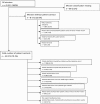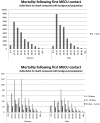Characteristics and prognoses of patients treated by an anaesthesiologist-manned prehospital emergency care unit. A retrospective cohort study
- PMID: 28232468
- PMCID: PMC5337743
- DOI: 10.1136/bmjopen-2016-014383
Characteristics and prognoses of patients treated by an anaesthesiologist-manned prehospital emergency care unit. A retrospective cohort study
Abstract
Objective: When planning and dimensioning an emergency medical system, knowledge of the population serviced is vital. The amount of literature concerning the prehospital population is sparse. In order to add to the current body of literature regarding prehospital treatment, thus aiding future public health planning, we describe the workload of a prehospital anaesthesiologist-manned mobile emergency care unit (MECU) and the total population it services in terms of factors associated with mortality.
Participants: The study is a register-based study investigating all missions carried out by a MECU operating in a mixed urban/rural area in Denmark from 1 May 2006 to 31 December 2014. Information on missions was extracted from the local MECU registry and linked at the individual level to the Danish population-based databases, the National Patient Registry and the Civil Registration System.
Primary and secondary outcome measures: Primary outcome measures were number of missions and number of patient contacts. Secondary patient variables were mortality and association between mortality and age, sex, comorbidity, prior admission to hospital and response time.
Results: The MECU completed 41 513 missions (mean 13.1 missions/day) having 32 873 patient contacts, corresponding to 19.2 missions and 15.2 patient encounters per 1000 patient years. Patient variables: the median age was 57 years (range 0-108 years), 42.8% (42.3% to 43.4%) were women. For patients admitted to hospital alive, 30-day mortality was 5.7% (5.4% to 6.0%); 90-day mortality was 8.1% (7.8% to 8.5%) while 2-year mortality was 16.4% (16.0% to 16.8%). Increasing age, male sex, comorbidity and prior admission to hospital but not response time were associated with mortality.
Conclusions: Mortality following an incident requiring the assistance of a MECU was high in the first 2 years following the incident. MECU response time assessed as a continuous parameter was not associated with patient outcome.
Keywords: Mobile Emergency Care Unit; Prehospital Emergency Care; Prehospital cohort.
Published by the BMJ Publishing Group Limited. For permission to use (where not already granted under a licence) please go to http://www.bmj.com/company/products-services/rights-and-licensing/.
Conflict of interest statement
Figures



Similar articles
-
Critical interventions, diagnosis, and mortality in children treated by a physician-manned mobile emergency care unit.Scand J Trauma Resusc Emerg Med. 2025 Feb 20;33(1):30. doi: 10.1186/s13049-025-01346-x. Scand J Trauma Resusc Emerg Med. 2025. PMID: 39979973 Free PMC article.
-
Outcome following physician supervised prehospital resuscitation: a retrospective study.BMJ Open. 2015 Jan 7;5(1):e006167. doi: 10.1136/bmjopen-2014-006167. BMJ Open. 2015. PMID: 25567065 Free PMC article.
-
Large discrepancy between prehospital visitation to mobile emergency care unit and discharge diagnosis.Dan Med J. 2012 Apr;59(4):A4415. Dan Med J. 2012. PMID: 22459720
-
The Danish prehospital emergency healthcare system and research possibilities.Scand J Trauma Resusc Emerg Med. 2019 Nov 4;27(1):100. doi: 10.1186/s13049-019-0676-5. Scand J Trauma Resusc Emerg Med. 2019. PMID: 31684982 Free PMC article. Review.
-
Management of prehospital thrombolytic therapy in ST-segment elevation acute coronary syndrome (<12 hours).Minerva Anestesiol. 2005 Jun;71(6):297-302. Minerva Anestesiol. 2005. PMID: 15886591 Review.
Cited by
-
Prehospital emergency medical technicians can perform ultrasonography and blood analysis in prehospital evaluation of patients with chronic obstructive pulmonary disease: a feasibility study.BMC Health Serv Res. 2021 Mar 31;21(1):290. doi: 10.1186/s12913-021-06305-7. BMC Health Serv Res. 2021. PMID: 33789641 Free PMC article.
-
Physician staffed emergency medical service for children: a retrospective population-based registry cohort study in Odense region, Southern Denmark.BMJ Open. 2020 Aug 13;10(8):e037567. doi: 10.1136/bmjopen-2020-037567. BMJ Open. 2020. PMID: 32792443 Free PMC article.
-
Chief Complaints, Underlying Diagnoses, and Mortality in Adult, Non-trauma Emergency Department Visits: A Population-based, Multicenter Cohort Study.West J Emerg Med. 2022 Oct 31;23(6):855-863. doi: 10.5811/westjem.2022.9.56332. West J Emerg Med. 2022. PMID: 36409936 Free PMC article.
-
Prehospital Release of Patients After Treatment in an Anesthesiologist-Staffed Mobile Emergency Care Unit.JAMA Netw Open. 2022 Jul 1;5(7):e2222390. doi: 10.1001/jamanetworkopen.2022.22390. JAMA Netw Open. 2022. PMID: 35857324 Free PMC article.
-
Use of pre-hospital emergency medical services in urban and rural municipalities over a 10 year period: an observational study based on routinely collected dispatch data.Scand J Trauma Resusc Emerg Med. 2019 Apr 2;27(1):35. doi: 10.1186/s13049-019-0607-5. Scand J Trauma Resusc Emerg Med. 2019. PMID: 30940157 Free PMC article.
References
MeSH terms
LinkOut - more resources
Full Text Sources
Other Literature Sources
Medical
